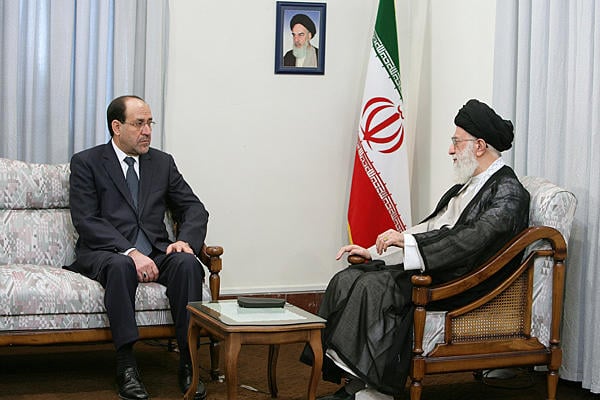 Over at The National, Hassan Hassan has authored an excellent analysis of Iraq’s complex relationship with Iran, and the evolving nature of her ties to the Arab Gulf states. Hassan suggests Iraq’s Arab neighbors should resist knee-jerk presumptions regarding another Persian proxy.
Over at The National, Hassan Hassan has authored an excellent analysis of Iraq’s complex relationship with Iran, and the evolving nature of her ties to the Arab Gulf states. Hassan suggests Iraq’s Arab neighbors should resist knee-jerk presumptions regarding another Persian proxy.
Hassan complements his take with an interesting aside regarding clerical connections between the two Shi’a states. Despite facile notions that Iraq’s sectarian penchants will inevitably land its Shi’a majority in Iran’s evolving orbit, Hassan reminds his readers of the sharp, spiritual divide that exists between the spiritual capitals of Najaf and Qom.
As he writes:
Iraqi Shia clergy are already resisting Iranian influence as the Najaf Hawza (the world’s oldest learning centre for Shia) tries to reclaim its prominence, overshadowed by Qom’s Hawza in Iran since 1979. Najaf and Qom deeply differ on the concept of clerical leadership. It is safe to say that the differences between Shia and Sunni Muslims over caliphate (on who should have succeeded the Prophet) are as deep as the differences among Shiites on imamate (who can lead Muslims).
As Hassan notes, Najaf is considered “hawza samitah” – in clerical terms, this connotes a “quietist” seminary. “Quietism” compels a passive political posture on the part of the clergy. In contrast, the prevailing logic in Qom suggests a cleric can lead the faithful until the return of the promised Mahdi, who’s currently tucked away in occultation. Of course, this is the line of thinking that led to Khomeini’s revolution and Iranian theocracy, by writ of vilayat e-faqih.
Khomeini divined this sacred custodianship as his major contribution to Shi’a Islamic theology. It’s an expansive, post-“Age of Mahdi Occultation” theory unique to Iran that presumes “guardianship” of Islamic jurisprudence is represented by a “supreme” clerical leader. This doyen is to be supported by his devotional lieutenants in other critical realms of governance – most notably the Assembly of Experts (all whom must boast clerical bona fides), the Council of Guardians (of whom, half must be ordained), the courts and state-appointed leaders of Friday prayers.
Hassan notes an important new figure, now emerging on our collective Western radar. The higher-ups in Qom are reportedly grooming cleric Ayatollah Mahmoud Hashemi Shahroudi to lead Iraq’s Shi’a after the death of Grand Ayatollah Ali Sistani. At present, Sistani serves as the highest ranking Twelver marja in Iraq, the de facto leader of the world’s Shi’a population (outside of Iran) and an important opponent of Khomeini’s vilayat vision for politico-Islamic guardianship. However, he is advanced in years, ailing in health and likely not long for this world.
If Shahroudi were to inherit Sistani’s position atop the clerical stacking chart, this could draw Iraq’s Shi’a population closer to their neighbors in Iran. While Sistani is Iranian by birth (and speaks his Arabic with a pronounced Persian accent), Shahroudi is an Iraqi transplant to Qom, and a powerful member of Iranian supreme leader Ali Khamanei’s inner circle. But he won’t become the next spiritual leader of Iraq’s Shi’a majority without the blessing and funding of leadership in Tehran.
Former Foreign Service office Peter Van Buren (who writes an excellent blog over at wemeantwell.com) notes a recent meeting between Iraqi Prime Minister Nouri al Maliki and Shahroudi could be one of the most overlooked, yet critical stories we missed this past week.
He writes:
Speaking privately, a senior official in Baghdad described the meeting as ”extremely significant”, revealing at least tacit support by Mr Maliki for an Iranian plan to have Ayatollah Shahroudi replace the ailing Ayatollah Ali al-Sistani as spiritual leader of Iraq’s Shiites.
Reidar Visser, an Oslo-based analyst of Iraqi affairs, sees formidable obstacles to the Shahroudi bid, but warned: “By visiting Shahroudi, Maliki did nothing to kill the rumours about some kind of Iranian design on the holiest centre of Iraqi Shiism. “If Shahroudi should succeed … those arguing that Maliki is moving towards even greater co-ordination with the Iranian clergy would feel vindicated – and rightly so.”
Put plainly, the clerical “closening” between these two states will prove vital to consider as Iraq entrenches an ever-deepening alliance with Iran.